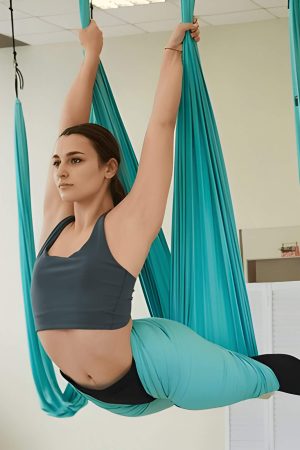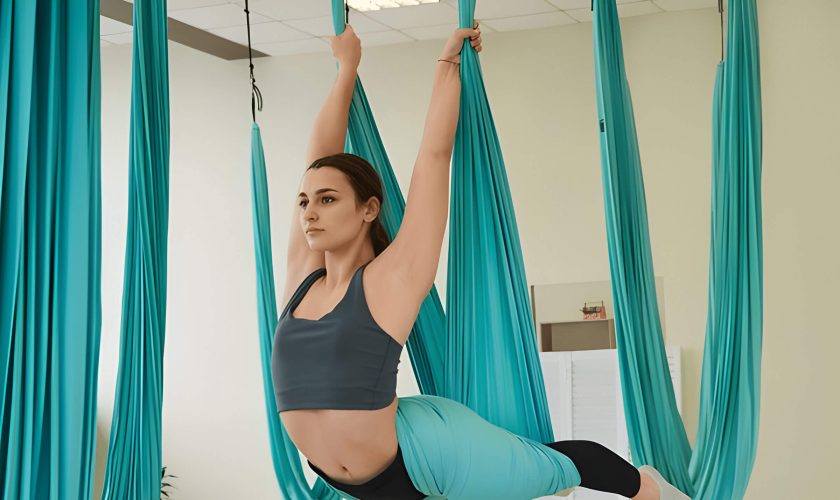Aerial yoga combines yoga, Pilates, and dance using a suspended hammock. It aids in challenging poses and deeper stretches, improving flexibility, strength, balance, relaxation, and mindfulness. This guide covers equipment choices, clears misconceptions, teaches basic poses, and integrates aerial yoga into your fitness routine.
What Is Aerial Yoga?
Aerial yoga, also known as anti-gravity yoga, is a unique form of exercise that combines traditional yoga poses, pilates, and dance with the use of a suspended hammock. This innovative practice allows participants to perform various poses while being supported by a soft fabric sling hanging from the ceiling.
The aerial yoga definition encompasses more than just physical fitness; it also aims to improve mental well-being and flexibility. By practicing aerial yoga, individuals can experience deeper stretches and inversions without putting too much strain on their joints and spine. This is particularly beneficial for those who may find traditional mat-based exercises challenging.
An introduction to aerial yoga typically involves learning how to safely use the hammock for support while transitioning between different poses. Beginners are often guided through basic movements that help build strength and confidence in using the apparatus. As practitioners become more comfortable, they can explore more advanced techniques that involve flips, spins, and complex stretches.
Understanding what is aerial yoga can open up new possibilities for enhancing your fitness routine. Whether you’re seeking improved flexibility, better posture, or simply a fun way to exercise, aerial yoga offers an exciting alternative that caters to various fitness levels and interests.
The Unique Benefits of Aerial Yoga for Your Body and Mind

Aerial yoga, an innovative form of exercise that combines traditional yoga poses with the use of a hammock or silk apparatus, offers a unique blend of physical and mental benefits. One of the primary aerial yoga benefits is its ability to enhance flexibility and strength. By performing poses while suspended in the air, practitioners can achieve deeper stretches and engage muscles that are often neglected in ground-based exercises.
The health benefits of aerial yoga extend beyond just physical improvements. This practice is particularly effective in decompressing the spine, which can alleviate back pain and improve overall posture. The anti-gravity nature of aerial yoga allows for a low-impact workout that reduces stress on joints while still providing a full-body workout.
In addition to physical advantages, there are significant mental benefits of aerial yoga. The practice encourages mindfulness and focus as it requires concentration to maintain balance and execute movements correctly. This heightened state of awareness can lead to reduced stress levels and improved mental clarity.
Furthermore, the sense of accomplishment from mastering challenging poses can boost self-confidence and foster a positive mindset. Overall, the combination of physical exertion and mindful practice makes aerial yoga an excellent choice for those looking to improve both their body and mind simultaneously.
Getting Started with Aerial Yoga (Essential Tips and Equipment)
Embarking on your aerial yoga journey can be both exciting and a bit daunting. This unique form of exercise combines traditional yoga poses, Pilates, and dance with the use of a hammock or silk fabric suspended from the ceiling. To help you get started with aerial yoga, we’ve compiled some essential tips and necessary equipment to ensure a smooth beginning.
Beginner Tips for Aerial Yoga
1. Find a Qualified Instructor: Before diving into aerial yoga, it’s crucial to find an experienced instructor who can guide you safely through the poses. Look for certified professionals who have a background in both yoga and aerial techniques.
2. Start Slow: As with any new fitness routine, it’s important to start slow and gradually build your strength and flexibility. Begin with beginner-level classes that focus on foundational moves before progressing to more advanced sequences.
3. Listen to Your Body: Pay close attention to how your body feels during each session. Aerial yoga involves hanging upside down and other unfamiliar positions that may take time for your body to adjust to. If something doesn’t feel right, don’t hesitate to modify the pose or take a break.
4. Dress Comfortably: Wear fitted clothing that allows for full range of motion but isn’t so loose that it gets tangled in the hammock. Avoid wearing jewelry or anything that could snag on the fabric.
Necessary Equipment for Aerial Yoga
1. Aerial Hammock/Silk Fabric: The main piece of equipment you’ll need is an aerial hammock made from strong, high-quality silk fabric designed specifically for aerial practices. Ensure it is securely installed by professionals if setting up at home.
2. Supportive Mat: While much of aerial yoga takes place off the ground, having a supportive mat underneath can provide comfort during floor exercises and serve as cushioning in case of falls.
3. Carabiners & Rigging Hardware: High-quality carabiners and rigging hardware are essential for safely securing your hammock to its anchor points on the ceiling or frame structure.
4. Ceiling Mounts/Frames: If practicing at home, you’ll need sturdy ceiling mounts or freestanding frames specifically designed to bear weight safely during inversions and other movements.
By following these beginner tips for aerial yoga and ensuring you have all necessary equipment ready, you’ll be well-prepared to dive into this invigorating practice confidently!
Common Misconceptions About Aerial Yoga Debunked
Aerial yoga has gained popularity in recent years, but with its rise, several misconceptions have also emerged. Let’s debunk some common aerial yoga myths and uncover the truth about this unique practice.
Myth 1. Aerial Yoga is Only for the Extremely Fit
One of the most pervasive misconceptions about aerial yoga is that it’s only suitable for those who are already extremely fit or flexible. In reality, aerial yoga can be adapted to suit various fitness levels. The use of a hammock provides support and allows practitioners to perform poses with greater ease, making it accessible even for beginners.
Myth 2. It’s Dangerous
Another common myth is that aerial yoga is inherently dangerous due to the use of suspended hammocks. While any physical activity carries some risk, aerial yoga is generally safe when practiced under proper guidance. Certified instructors ensure that hammocks are securely anchored and teach participants how to use them safely.
Myth 3. It’s Just a Trendy Fad
Some believe that aerial yoga is merely a passing trend with no real benefits. However, this practice combines traditional yoga poses with elements of acrobatics and Pilates, offering a comprehensive workout that improves strength, flexibility, and balance. Its holistic approach contributes significantly to both physical and mental well-being.
Myth 4. You Need Special Equipment at Home
Many people think they need to invest in expensive equipment to try aerial yoga at home. While having your own hammock can be beneficial for home practice, many studios provide all necessary equipment during classes. This allows newcomers to experience the benefits without an initial investment.
By debunking these misconceptions about aerial yoga, we hope more people will feel encouraged to explore this enriching practice without hesitation or fear.
A Beginner’s Guide to Basic Aerial Yoga Poses and Techniques
Aerial yoga, a unique blend of traditional yoga and aerial arts, offers a refreshing way to enhance your flexibility, strength, and mindfulness. For beginners eager to explore this practice, starting with basic aerial yoga poses and techniques is essential. Here are some easy poses in aerial yoga that will help you get started on the right foot.
1. The Aerial Mountain Pose: This foundational pose helps you get accustomed to using the hammock. Stand with your feet hip-width apart, holding onto the fabric at waist height. Engage your core and maintain an upright posture as you breathe deeply.
2. Supported Chair Pose: Begin by sitting in the hammock like a swing with both feet flat on the ground. Lean back slightly while gripping the fabric for support. This pose strengthens your legs and improves balance without putting strain on your joints.
3. Star Inversion: An excellent introduction to inversions, this pose allows you to experience being upside down safely. With the hammock supporting your hips, let yourself hang freely while extending your arms and legs outward like a starfish.
4. Floating Savasana: End your practice with this relaxing technique by lying fully extended in the hammock like you’re in a cocoon. This pose promotes deep relaxation and helps release tension from both body and mind.
By incorporating these basic aerial yoga techniques into your routine, you’ll build confidence and develop a solid foundation for more advanced poses as you progress in your practice of aerial yoga poses for beginners.
How to Incorporate Aerial Yoga into Your Regular Fitness Routine
Incorporating aerial yoga into your regular fitness routine can bring a fresh and dynamic dimension to your workouts. Combining fitness routines with aerial yoga not only enhances flexibility and strength but also provides a unique way to engage different muscle groups. Here’s how you can effectively integrate aerial fitness into your workouts:
1. Start with the Basics: If you’re new to aerial yoga, begin by familiarizing yourself with the fundamental poses and techniques. Many studios offer beginner classes that focus on building foundational skills.
2. Schedule Regular Sessions: Consistency is key when integrating any new activity into your fitness routine. Aim for at least one or two aerial yoga sessions per week to allow your body to adapt and improve.
3. Combine Strength Training: Aerial yoga can complement traditional strength training exercises. Use it as a warm-up or cool-down session to stretch out muscles worked during weightlifting or resistance training.
4. Focus on Core Engagement: Aerial yoga requires significant core stability, making it an excellent addition for enhancing core strength. Incorporate poses that challenge your balance and engage your abdominal muscles.
5. Customize Your Routine: Tailor your aerial yoga practice to fit your personal fitness goals. Whether you’re looking to increase flexibility, build strength, or improve balance, there are specific poses and sequences that can help you achieve these objectives.
6. Listen to Your Body: As with any new exercise regimen, it’s important to listen to your body and avoid pushing yourself too hard too soon. Gradually increase the intensity of your sessions as you become more comfortable with the movements.
By integrating aerial fitness into workouts, you’ll not only diversify your exercise routine but also enjoy the numerous physical benefits it offers. With dedication and practice, aerial yoga can become a rewarding component of a well-rounded fitness plan.
Conclusion- Embrace the Transformation with Aerial Yoga Today!
Aerial yoga offers a unique and transformative experience that combines traditional yoga poses, Pilates, and dance with the support of a hammock. This innovative form of exercise not only enhances flexibility and strength but also provides a sense of weightlessness that can alleviate stress and improve mental clarity.
The benefits of aerial yoga are extensive. Physically, it helps in decompressing the spine, improving joint mobility, and increasing overall body strength. Mentally, the practice encourages mindfulness and relaxation by allowing practitioners to focus on their movements and breath in a new dimension.
Whether you’re a seasoned yogi or new to the practice, aerial yoga presents an opportunity to challenge yourself in new ways while reaping numerous health benefits. It’s an excellent way to diversify your fitness routine, build confidence, and enjoy the exhilarating sensation of floating.
Embrace this transformative journey today by incorporating aerial yoga into your wellness regimen. The unique combination of physical exertion and mental tranquility promises not just a workout but an uplifting experience that can enhance your overall well-being.


